Space probe
Space probe
Jump to navigation
Jump to search

Abandoned 1974 probe, Pioneer H, on display in the National Air and Space Museum

Diagram of extant Solar System missions
A space probe is a robotic spacecraft that does not orbit Earth, but instead, explores further into outer space.[1] A space probe may approach the Moon; travel through interplanetary space; flyby, orbit, or land on other planetary bodies; or enter interstellar space.
The space agencies of the USSR (now Russia and Ukraine), the United States, the European Union, Japan, China, and India have collectively launched probes to several planets and moons of the Solar System, as well as to a number of asteroids and comets. Approximately 15 missions are currently operational.[2]
Contents
1 Interplanetary trajectories
2 Some notable probes
2.1 Luna 9
2.2 Luna 3
2.3 Luna 16
2.4 Lunokhod 1
2.5 Mariner 10
2.6 Venera 4
2.7 Venera 7
2.8 Mariner 9
2.9 Mars 3
2.10 Sojourner
2.11 Spirit and Opportunity
2.12 Halley Armada
2.12.1 ICE
2.12.2 Vega
2.12.3 Sakigake
2.12.4 Suisei
2.12.5 Giotto
2.13 Genesis
2.14 Stardust
2.15 NEAR Shoemaker
2.16 Hayabusa
2.17 Rosetta
2.18 Pioneer 10
2.19 Pioneer 11
2.20 Voyager 1
2.21 Voyager 2
2.22 Cassini–Huygens
2.23 New Horizons
2.24 Dawn
2.25 Juno
2.26 Chang'e 2
2.27 Beyond the Solar System
3 Probe imagers
4 Gallery
5 See also
6 References
7 Sources
8 Further reading
9 External links
Interplanetary trajectories[edit]
Once a probe has left the vicinity of Earth, its trajectory will likely take it along an orbit around the Sun similar to the Earth's orbit. To reach another planet, the simplest practical method is a Hohmann transfer orbit. More complex techniques, such as gravitational slingshots, can be more fuel-efficient, though they may require the probe to spend more time in transit. Some high Delta-V missions (such as those with high inclination changes) can only be performed, within the limits of modern propulsion, using gravitational slingshots. A technique using very little propulsion, but requiring a considerable amount of time, is to follow a trajectory on the Interplanetary Transport Network.[3]
Some notable probes[edit]
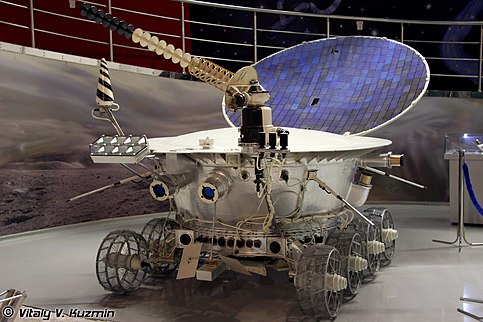
The Lunokhod 1 unmanned rover on the surface of Moon, displayed in Memorial Museum of Cosmonautics.

The Curiosity rover on the surface of Mars.
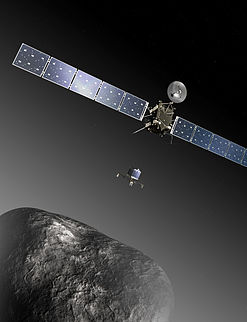
The Rosetta orbiter and Philae lander nearing comet 67P.
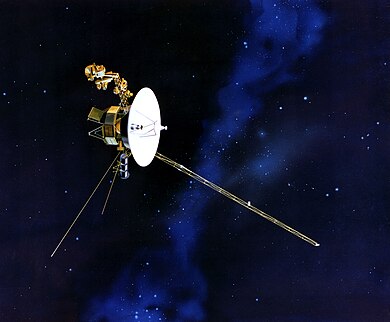
Voyager 2 in interplanetary space.

Artist's concept of Deep Impact prior to its planned collision with comet Tempel 1.
Luna 9[edit]
First man-made object to soft land on the Moon, or any other extra terrestrial surface.[4]
Luna 3[edit]
First mission to photograph the far side of the Moon, launched in 1959.
Luna 16[edit]
First robotic sample return probe from the Moon.
Lunokhod 1[edit]
First rover on Moon. It was sent to the Moon on November 10, 1970.
Mariner 10[edit]
First probe to Mercury.
Venera 4[edit]
First successful in-place analysis of another planet. It may have also been the first space probe to impact the surface of another planet, although it is unclear whether it reached Venus' surface.[5]
Venera 7[edit]
The Venera 7 probe was the first spacecraft to successfully soft land on another planet (Venus) and to transmit data from there back to Earth.
Mariner 9[edit]
Upon its arrival at Mars on November 13, 1971, Mariner 9 became the first space probe to maintain orbit around another planet.[6]
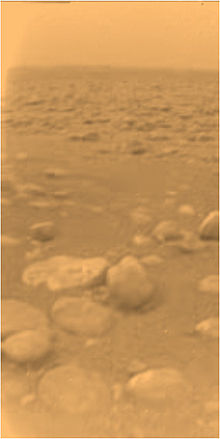
The Huygens landing site on Titan
Mars 3[edit]
First soft landing on Mars (December 2, 1971[7]) The lander began transmitting to the Mars 3 orbiter 90 seconds after landing. After 20 seconds, transmission stopped for unknown reasons.[7]
Sojourner[edit]
First successful rover on Mars.[8]
Spirit and Opportunity[edit]
The Mars Exploration Rovers, Spirit and Opportunity landed on Mars to explore the Martian surface and geology, and searched for clues to past water activity on Mars. They were each launched in 2003 and landed in 2004. Communication with Spirit stopped on sol 2210 (March 22, 2010).[9][10] JPL continued to attempt to regain contact until May 24, 2011, when NASA announced that efforts to communicate with the unresponsive rover had ended.[11][12][13]Opportunity arrived at Endeavour crater on 9 August 2011, at a landmark called Spirit Point named after its rover twin, after traversing 13 miles (21 km) from Victoria crater, over a three-year period.[14] As of January 26, 2016, Opportunity has lasted for more than twelve years on Mars — although the rovers were intended to last only three months.
Halley Armada[edit]
The first dedicated missions to a comet; in this case, to Halley's Comet during its 1985–86 journey through the inner Solar System. It was also the first massive international coordination of space probes on an interplanetary mission, with probes specifically launched by the Soviet (now Russian) Space Agency, European Space Agency, and Japan's ISAS (now integrated with NASDA to JAXA).
ICE[edit]
Originally a solar observatory in the International Sun-Earth Explorer series, it was sent into solar orbit to make the first close observations of a comet, Comet Giacobini–Zinner, in 1985 as a prelude to studies of Halley's Comet.
Vega[edit]
Two Russian/French spacecraft. They dropped landers and balloons (first weather balloons deployed on another planet) at Venus before their rendezvous with Halley's Comet.
Sakigake[edit]
This Japanese probe was the first non-US, non-Soviet interplanetary probe.[citation needed]
Suisei[edit]
A second Japanese probe, it made ultraviolet wavelength observations of the comet.[clarification needed]
Giotto[edit]
The first space probe to penetrate a comet's coma and take close-up images of its nucleus.
Genesis[edit]
First solar wind sample return probe from sun-earth L1.[15]
Stardust[edit]
First sample return probe from a comet tail.
NEAR Shoemaker[edit]
First probe to land on an asteroid.
Hayabusa[edit]
First sample return probe to launch from an asteroid.
Rosetta[edit]
The Rosetta space probe flew by two asteroids and made a rendezvous and orbited comet 67P/Churyumov-Gerasimenko in November 2014.[16]
Pioneer 10[edit]
First probe to Jupiter.
Radio communications were lost with Pioneer 10 on January 23, 2003, because of the loss of electric power for its radio transmitter, with the probe at a distance of 12 billion kilometers (80 AU) from Earth.
Pioneer 11[edit]
First probe to fly by Saturn. (Communications were later lost due to power constraints and vast distance.)
Voyager 1[edit]

Voyager 1's view of Solar System (artist's impression).[17]
Voyager 1 is a 733-kilogram probe launched September 5, 1977. It visited Jupiter and Saturn and was the first probe to provide detailed images of the moons of these planets.
Voyager 1 is the farthest human-made object from Earth, traveling away from both the Earth and the Sun at a relatively faster speed than any other probe.[18] As of September 12, 2013, Voyager 1 is about 12 billion miles (19 billion kilometers) from the Sun.[19]
On August 25, 2012, Voyager 1 became the first human made object to enter interstellar space.[20]Voyager 1 has not had a functioning plasma sensor since 1980, but a solar flare in 2012 allowed scientists from NASA to measure vibrations of the plasma surrounding the craft. The vibrations allowed scientists to measure the plasma to be much denser than measurements taken in the far layers of our heliosphere, thus concluding the craft had broken beyond the heliopause.
Voyager 2[edit]
Voyager 2 was launched by NASA on August 20, 1977. The probe's primary mission was to visit the ice giants, Uranus and Neptune, which it completed on October 2, 1989. It is currently the only probe to have visited the ice giants. It is the fourth of five spacecraft to have left the solar system. It has been operational for 41 years and 2 months as of October 20, 2018.
Cassini–Huygens[edit]
Cassini–Huygens was a 5,712kg (12,593lb) space probe designed to study gas giant Saturn, along with its ringed system and moons. The NASA probe was launched with ESA lander Huygens on October 1, 1997 from Cape Canaveral. The Cassini probe entered Saturn orbit on July 1, 2004, and Huygens landed on Titan, Saturn's largest moon, on January 14, 2005.[21] On September 15, 2017, the probe was de-orbited and burned up in Saturn's atmosphere, after almost 20 years in space.
New Horizons[edit]
First probe to be launched to Pluto. Launched on January 19, 2006, it flew by the Pluto–Charon system on July 14, 2015.[22]
Dawn[edit]
First spacecraft to visit and orbit a protoplanet (4 Vesta), entering orbit on July 16, 2011.[23][24] Entered orbit around dwarf planet Ceres in early 2015. Currently orbiting Ceres as of February 2017.
Juno[edit]
First probe to Jupiter without atomic batteries,[25] launched August 8, 2011.
Chang'e 2[edit]
Chang'e 2 was deployed to orbit the Moon, visit Sun–Earth L2 Lagrangian point, and make a flyby of asteroid 4179 Toutatis.[citation needed]
Beyond the Solar System[edit]
Along with Pioneer 10, Pioneer 11, and its sister space probe Voyager 2, Voyager 1 is now an interstellar probe. Voyager 1 and 2 have both achieved solar escape velocity, meaning that their trajectories will not return them to the Solar System.[26][27]
Probe imagers[edit]
Examples of space probe imaging telescope/cameras (focused on visible spectrum).
| Name | Aperture cm (in.) | Type | Where | When |
|---|---|---|---|---|
Mars Reconnaissance Orbiter—HiRISE | 50 cm (19.7″) | R/C | Mars orbit | 2005 |
Mars Global Surveyor—MOC[28] | 35 cm (13.8″) | R/C | Mars orbit | 1996–2006 |
New Horizons—LORRI[citation needed] | 20.8 cm (8.2″) | R/C | Space (33+ AU from Earth) | 2006 |
Lunar Reconnaissance Orbiter LROC-NAC[29] | 19.5 cm (7.68″) | Reflector | Lunar orbit | 2009 |
Cassini—ISS-NAC[30] | 19 cm (7.5″) | Reflector | Saturn orbit | 2004–2017 |
Galileo – Solid State Imager[31] | 17.65 cm (6.95″) | Reflector | Jupiter | 1989–2003 |
Voyager 1/2, ISS-NAC[32] | 17.6 cm (6.92″) | Catadioptric | Space | 1977 |
Mariner 10 – TV Photo Experiment (x2)[33] | 15 cm (5.9″) | Reflector | Space | 1973–1975 |
Deep Space 1—MICAS[34] | 10 cm ( 3.94″) | Reflector | Solar orbit | 1998–2001 |
Voyager 1/2, ISS-WAC[32] | 6 cm (2.36″) | Lens | Space | 1977 |
Cassini—ISS-WAC[30] | 5.7 cm (2.2″) | Lens | Saturn orbit | 2004–2017 |
MESSENGER MDIS-WAC[35] | 3 cm (1.18″) | Lens | Mercury orbit | 2004–2015 |
MESSENGER MDIS-NAC[36] | 2.5 cm (0.98″) | R/C | Mercury orbit | 2004–2015 |
Dawn Framing Camera (FC1/FC2)[37] | 2 cm (0.8″) | Lens | Asteroid belt | 2007–2018 |
Image forming systems on space probes typically have a multitude of specifications, but aperture can be useful because it constrains the best diffraction limit and light gathering area.[citation needed]
Gallery[edit]

Photograph of Voyager 1 / Voyager 2

Artist's concept of Pioneer 10 / Pioneer 11

Artist's concept of Pioneer 10 near Jupiter

Artist's concept of New Horizons approaching Pluto.

Artist's concept of New horizons near Pluto.

Artist's concept of Cassini in Saturn's Orbit

Artist's concept of Galileo encounter with Io

Artist depiction of Stardust during the 'burn-to-depletion' phase
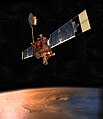
Artist depiction of Mars Global Surveyor

Titan4b on Launch pad
See also[edit]
- Interplanetary contamination
- Interstellar probe
- List of Solar System probes
Mariner 10 1973–1975
- Orbit
Pioneer 10 1972–2003
- Robotic spacecraft
- Space capsule
- Space exploration
- Unmanned spacecraft
- U.S. space exploration history on U.S. stamps
Viking program 1975–1982
References[edit]
^ "Space Probes". National Geographic Education. National Geographic Society..mw-parser-output cite.citation{font-style:inherit}.mw-parser-output q{quotes:"""""""'""'"}.mw-parser-output code.cs1-code{color:inherit;background:inherit;border:inherit;padding:inherit}.mw-parser-output .cs1-lock-free a{background:url("//upload.wikimedia.org/wikipedia/commons/thumb/6/65/Lock-green.svg/9px-Lock-green.svg.png")no-repeat;background-position:right .1em center}.mw-parser-output .cs1-lock-limited a,.mw-parser-output .cs1-lock-registration a{background:url("//upload.wikimedia.org/wikipedia/commons/thumb/d/d6/Lock-gray-alt-2.svg/9px-Lock-gray-alt-2.svg.png")no-repeat;background-position:right .1em center}.mw-parser-output .cs1-lock-subscription a{background:url("//upload.wikimedia.org/wikipedia/commons/thumb/a/aa/Lock-red-alt-2.svg/9px-Lock-red-alt-2.svg.png")no-repeat;background-position:right .1em center}.mw-parser-output .cs1-subscription,.mw-parser-output .cs1-registration{color:#555}.mw-parser-output .cs1-subscription span,.mw-parser-output .cs1-registration span{border-bottom:1px dotted;cursor:help}.mw-parser-output .cs1-hidden-error{display:none;font-size:100%}.mw-parser-output .cs1-visible-error{font-size:100%}.mw-parser-output .cs1-subscription,.mw-parser-output .cs1-registration,.mw-parser-output .cs1-format{font-size:95%}.mw-parser-output .cs1-kern-left,.mw-parser-output .cs1-kern-wl-left{padding-left:0.2em}.mw-parser-output .cs1-kern-right,.mw-parser-output .cs1-kern-wl-right{padding-right:0.2em}
^ "Planetary Exploration Timelines: A Look Ahead to 2016". The Planetary Society.
^ "E&S+". E&S+.
^ "NASA – NSSDCA – Spacecraft – Details".
^ "NASA – NSSDCA – Spacecraft – Details".
^ http://marsprogram.jpl.nasa.gov/missions/past/mariner8-9.html
^ ab Mars 3 Lander. NASA Space Science Data Coordination. NASA
^ Sojourner (rover)
^ September 30 – October 05, 2010 Spirit Remains Silent at Troy NASA. 2010-10-05.
^ A.J.S. Rayl Mars Exploration Rovers Update Planetary Society 30 November 2010
^ Webster, Guy (25 May 2011). "NASA's Spirit Rover Completes Mission on Mars". NASA. Retrieved 2011-10-12.
^ "NASA Concludes Attempts to Contact Mars Rover Spirit". NASA. Retrieved 25 May 2011.
^ Chang, Kenneth (May 24, 2011). "NASA to Abandon Mars Spirit Rover". New York Times.
^ NASA Mars Rover Arrives at New Site on Martian Surface Jet Propulsion Laboratory, 10 August 2011.
^ "Genesis – Search for Origins". Jet Propulsion Laboratory. Retrieved July 13, 2016.
^ ""Where Comets Emit Dust: Scientists Identify the Active Regions on the Surface of Comets" – ScienceDaily (Apr. 29, 2010)". sciencedaily.com.
^ "Voyager 1's view of Solar System (artist's impression)". www.spacetelescope.org. Retrieved 12 January 2017.
^ "NASA Voyager 1 Encounters New Region in Deep Space". NASA.
^ JPL.NASA.GOV. "Voyager – The Interstellar Mission". nasa.gov.
^ "NASA Spacecraft Embarks on Historic Journey Into Interstellar Space". NASA.
^ "Huygens Probe Separation and Coast Phase".
^ Brown, Dwayne; Buckley, Michael; Stothoff, Maria (15 January 2015). "January 15, 2015 Release 15-011 – NASA's New Horizons Spacecraft Begins First Stages of Pluto Encounter". NASA. Retrieved 15 January 2015.
^ "NASA's Dawn Spacecraft Hits Snag on Trip to 2 Asteroids". Space.com. August 15, 2012. Retrieved August 27, 2012.
^ "Dawn Gets Extra Time to Explore Vesta". NASA. April 18, 2012. Retrieved April 24, 2012.
^ "NASA's Juno Mission to Jupiter to Be Farthest Solar-Powered Trip". Retrieved October 2, 2015.
^ "Voyager-The Interstellar Mission: Fast Facts". Jet Propulsion Laboratory. Retrieved November 2, 2013.
^ "Voyager-The Interstellar Mission". Jet Propulsion Laboratory. Retrieved November 2, 2013.
^ "Mars Global Surveyor". Archived from the original on 2012-02-19.
^ "eoportal – LRO (Lunar Reconnaissance Orbiter) – LROC". Archived from the original on 2012-03-16.
^ ab "Cassini Solstice Mission: ISS". Cassini Solstice Mission. Archived from the original on 2015-01-14.
^ "Basics of Space Flight Section II. Space Flight Projects". nasa.gov.
^ ab "Voyager". astronautix.com.
^ "NASA – NSSDCA – Experiment – Details".
^ "Deep Space 1". nasa.gov.
^ "NASA – NSSDCA – Experiment – Details".
^ "NASA PDS – MDIS". Archived from the original on 2010-06-02.
^ "Sierks, et al. – The Dawn Framing Camera: A Telescope En Route to the Asteroid Belt – MPS/DLR/IDA".
Sources[edit]
Deep Space: The NASA Mission Reports. edited by Robert Godwin (2005).
ISBN 1-894959-15-9
Further reading[edit]
McNutt, et al. – Radioisotope Electric Propulsion (2006) – NASA Glenn Research Center (includes Centaur orbiter mission)- Scott W. Benson – Solar Power for Outer Planets Study (2007) – NASA Glenn Research Center
External links[edit]
 Media related to Space probes at Wikimedia Commons
Media related to Space probes at Wikimedia Commons- JPL – What Is a Space Probe? (2010)
Categories:
- Space probes
- Unmanned spacecraft
(window.RLQ=window.RLQ||).push(function(){mw.config.set({"wgPageParseReport":{"limitreport":{"cputime":"0.884","walltime":"1.230","ppvisitednodes":{"value":5034,"limit":1000000},"ppgeneratednodes":{"value":0,"limit":1500000},"postexpandincludesize":{"value":163181,"limit":2097152},"templateargumentsize":{"value":6659,"limit":2097152},"expansiondepth":{"value":12,"limit":40},"expensivefunctioncount":{"value":7,"limit":500},"unstrip-depth":{"value":1,"limit":20},"unstrip-size":{"value":95001,"limit":5000000},"entityaccesscount":{"value":1,"limit":400},"timingprofile":["100.00% 934.441 1 -total"," 27.96% 261.305 1 Template:Reflist"," 23.15% 216.283 30 Template:Cite_web"," 23.07% 215.550 7 Template:Navbox"," 19.01% 177.608 1 Template:Spaceflight"," 17.14% 160.125 22 Template:Flagicon"," 10.03% 93.696 1 Template:Commons_category_inline"," 8.88% 82.973 4 Template:Citation_needed"," 7.76% 72.480 4 Template:Fix"," 4.82% 44.996 10 Template:Category_handler"]},"scribunto":{"limitreport-timeusage":{"value":"0.348","limit":"10.000"},"limitreport-memusage":{"value":8588190,"limit":52428800}},"cachereport":{"origin":"mw1322","timestamp":"20190106162107","ttl":1900800,"transientcontent":false}}});});{"@context":"https://schema.org","@type":"Article","name":"Space probe","url":"https://en.wikipedia.org/wiki/Space_probe","sameAs":"http://www.wikidata.org/entity/Q26529","mainEntity":"http://www.wikidata.org/entity/Q26529","author":{"@type":"Organization","name":"Contributors to Wikimedia projects"},"publisher":{"@type":"Organization","name":"Wikimedia Foundation, Inc.","logo":{"@type":"ImageObject","url":"https://www.wikimedia.org/static/images/wmf-hor-googpub.png"}},"datePublished":"2007-03-22T19:48:16Z","dateModified":"2018-12-20T04:26:30Z","image":"https://upload.wikimedia.org/wikipedia/commons/d/db/Pioneer_H.JPG","headline":"unmanned robotic spacecraft that does not orbit the Earth, but, instead, explores further into outer space"}(window.RLQ=window.RLQ||).push(function(){mw.config.set({"wgBackendResponseTime":1376,"wgHostname":"mw1322"});});
















